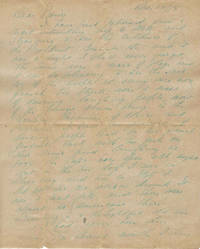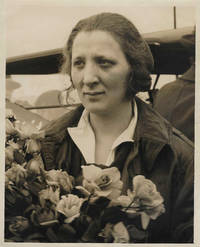by (Pennsylvania – Early Iron Industry)
Early Pennsylvania Iron Industry – Forge Founded by Maj. Gen Arthur St. Clair.
The collection contains two ledgers:
Johnston, Alexander, Manuscript Ledger Relating to The Hermitage Furnace, Grist Mill and Store in Westmoreland County, 1810-1812
Folio, 396 manuscript pages, 20-page name index, entries written neatly in ink, bound in contemporary full sheep, tooled in blind, spine label, binding worn, hinges starting, text in very good, clean and legible condition. Johnstons' partial signature is found on the front board.
A contemporary manuscript note on the front free endpaper states "Bound for Patterson & Hopkins in Pittsb." This firm was the short-lived Pittsburgh book-selling business conducted by Robert Paterson and John Hopkins which lasted from 1810 until it was dissolved on November 5, 1812. The business of this company was continued thenceforth until the end of 1817, under the new firm of Robert & Joseph Patterson. While this firm mostly sold books and stationery and supplied local printshops with paper, the two brothers also conducted some small-scale publishing, perhaps mostly using the press owned by Silas Engles.
Another contemporary manuscript note taking up most of the rear free endpaper states: "Ledger a for A. Johnston Esqr by James Nouman 1810 for Hermitage Furnace" – perhaps Nouman was the binder.
The ledger contains accounts for the Hermitage Furnace as well as a grist mill and general store under the management of Alexander Johnston. St. Clair in addition to the Hermitage Furnace also operated "a mill and other property", including a blacksmith shop, these were all likely the properties leased by St. Clair about 1806 to Pittsburgh capitalists. The account book contains entries for various castings produced by the furnace, bar iron, and tools used in production, forge hammers, et cetera. There are also accounts for Johnstons' own Kingston Furnace, the Washington Furnace, another Westmoreland County Furnace, and the Youngstown Store, as well as numerous individuals, many of whom were likely Hermitage Furnace workers. The general store accounts may have been an early "company store" for Hermitage workers and nearby farmers.
Manuscript Ledger containing Accounts for Alexander Johnston, 1805-1850
Narrow folio, 236 pages, several inlaid items, bound in contemporary sheep, binding worn and shaken, identified as "Ledger F" on front cover, Alexander Johnstons ownership on rear cover, a number of pages excised at rear, the volume was used as a "herbarium" at one point, there are stains from plant specimens, however the entries are clean and legible.
"The iron industry of Pennsylvania took root in the eighteenth century in the southeastern part of the state, but as the frontier moved westward, ironworks were established not far behind. Furnaces and forges quickly sprang up to supply the agricultural communities with iron products that were badly needed. The spread settlement afforded men of initiative and capital the opportunity of producing iron first for a local market and then in many cases, for more distant markets. At the beginning of the nineteenth century, frontier conditions still prevailed in many parts of Pennsylvania, but the iron industry – at that time a combination of iron manufacture and agriculture – played an important part in the development of the economic life of the state and the nation, and in bringing about the change from an agrarian to an industrial civilization.
During the first part of the nineteenth century all the iron furnaces in the country were cold-blast furnaces. By the time of the Civil War, however, technological changes were taking place, as can be seen in the use of bituminous and anthracite coal or coke as fuel in many furnaces and in the application of a hot blast instead of a coal one …
The blast furnace, with its casting house, blast house, stock house and wooden blowing cylinders or tubs, operated by an overshot water wheel or steam engine, was an impressive sight in its agricultural setting when in blast. Not far from the plant were the houses of the workers, the "mansion house" of the ironmaster, the office, the stables and the smith shop. Many of these communities also included a forge where pig iron from the blast furnace was heated and hammered into the bars of commerce. … old iron furnaces, were part of a busy community, where families, lived, toiled and died …" – Arthur C. Bining.
The Hermitage Furnace was the second built in Westmoreland County, Pennsylvania. The furnace was built by Major General Arthur St. Clair, after he returned from the governorship of Ohio, circa 1802-1803. The furnace was built at The Hermitage, the onetime home of St. Clair, located about two miles northeast of Ligonier, on the road leading to Johnstown. St. Clair built the furnace in hopes of restoring his depleted fortune. The furnace was first managed by James Hamilton, a prominent Carlisle, Pennsylvania lawyer named deputy attorney general of the Western District of Pennsylvania by Thomas Jefferson. (Hamilton's name appears several times in the ledger.)
An advertisement in the November 21, 1806, issue of the Farmer's Register, published in Greensburg by John M. Snowden, taken out by Henry Weaver & Son, Greensburg merchants, it reads:
"Hermitage Furnace in Blast. The subscribers, being appointed Agents by General Arthur St. Clair, for the sale of his castings generally, and for the delivery of castings and stoves for any number of tons, in good terms. Samples of the castings and stoves to be seen at their store, in Greensburg, at any time after the 10th inst."
At Hermitage Furnace they were compelled to use a small amount of coal in the blacksmith shop, this was packed in sacks and shipped from a mine in Lockport, on the Conemaugh River, a distance of about 12 miles. This was kept up until about 1807-08 when a great flood which washed away the surface ground near Ligonier, exposing the previously unknown Pittsburgh coal seam. Coal banks were opened, and they used their own coal instead of Lockport coal. In 1818 when lots were advertised for sale in Ligonier, the coal banks a mile or two from the proposed town were used as an inducement to prospective settlers.
Shortly after 1806 General St. Clair abandoned the management of the furnace himself, and leased it, with his mill and some other property, to some Pittsburgh investors for about $ 3000.00 per year. St. Clair's creditors were closing in on him and in 1810 the furnace was sold by the sheriff and purchased by James O'Hara. Alexander Johnston, prominent iron master and sheriff, justice of the peace and treasurer of Westmoreland County must have had a financial interest in the furnace.
Johnston was born in Enniskillen, County Fermanagh, Northern Ireland, July 10, 1773, he emigrated to America in 1797. He married Elizabeth Freame. The couple then operated a hotel in Greensburg, then removed to Pittsburgh where Johnston trained to be an iron master, and after along life spent mostly in western Pennsylvania, died in Kingston, Westmoreland County, in 1872. He began work in the iron industry in the late 18th century, beginning with his own Kingston Furnace, which wasn't a success. The main ledger offered here was kept beginning at the time when St. Clair sold the furnace in 1810. One of the early pages in the ledger lists the times the Hermitage Furnace "blew", "stopt", or "quit." It appears Johnston and others kept the furnace going until at least May 28, 1811, when "William Bailey quit managing."
The furnace seems to have remained idle, following the hard times of the Embargo, until 1816 when it was again put into blast by O'Hara and Skully, under the management of John Henry Hopkins. Hopkins was not a successful manager, and the furnace closed down in 1817 and never operated again.
Boucher, John N., History of Westmoreland County, vol. 1, pp. 445-457
New York: The Lewis Publishing Company, 1906
Harman, J. Paul, Stone-Stack Smelting Furnaces in Westmoreland County
Pennsylvania History: A Journal of Mid-Atlantic Studies, Vol. 19, No. 2 (April 1952), pp. 185-193
https://www.jstor.org/stable/277769302 (Inventory #: 31261)
The collection contains two ledgers:
Johnston, Alexander, Manuscript Ledger Relating to The Hermitage Furnace, Grist Mill and Store in Westmoreland County, 1810-1812
Folio, 396 manuscript pages, 20-page name index, entries written neatly in ink, bound in contemporary full sheep, tooled in blind, spine label, binding worn, hinges starting, text in very good, clean and legible condition. Johnstons' partial signature is found on the front board.
A contemporary manuscript note on the front free endpaper states "Bound for Patterson & Hopkins in Pittsb." This firm was the short-lived Pittsburgh book-selling business conducted by Robert Paterson and John Hopkins which lasted from 1810 until it was dissolved on November 5, 1812. The business of this company was continued thenceforth until the end of 1817, under the new firm of Robert & Joseph Patterson. While this firm mostly sold books and stationery and supplied local printshops with paper, the two brothers also conducted some small-scale publishing, perhaps mostly using the press owned by Silas Engles.
Another contemporary manuscript note taking up most of the rear free endpaper states: "Ledger a for A. Johnston Esqr by James Nouman 1810 for Hermitage Furnace" – perhaps Nouman was the binder.
The ledger contains accounts for the Hermitage Furnace as well as a grist mill and general store under the management of Alexander Johnston. St. Clair in addition to the Hermitage Furnace also operated "a mill and other property", including a blacksmith shop, these were all likely the properties leased by St. Clair about 1806 to Pittsburgh capitalists. The account book contains entries for various castings produced by the furnace, bar iron, and tools used in production, forge hammers, et cetera. There are also accounts for Johnstons' own Kingston Furnace, the Washington Furnace, another Westmoreland County Furnace, and the Youngstown Store, as well as numerous individuals, many of whom were likely Hermitage Furnace workers. The general store accounts may have been an early "company store" for Hermitage workers and nearby farmers.
Manuscript Ledger containing Accounts for Alexander Johnston, 1805-1850
Narrow folio, 236 pages, several inlaid items, bound in contemporary sheep, binding worn and shaken, identified as "Ledger F" on front cover, Alexander Johnstons ownership on rear cover, a number of pages excised at rear, the volume was used as a "herbarium" at one point, there are stains from plant specimens, however the entries are clean and legible.
"The iron industry of Pennsylvania took root in the eighteenth century in the southeastern part of the state, but as the frontier moved westward, ironworks were established not far behind. Furnaces and forges quickly sprang up to supply the agricultural communities with iron products that were badly needed. The spread settlement afforded men of initiative and capital the opportunity of producing iron first for a local market and then in many cases, for more distant markets. At the beginning of the nineteenth century, frontier conditions still prevailed in many parts of Pennsylvania, but the iron industry – at that time a combination of iron manufacture and agriculture – played an important part in the development of the economic life of the state and the nation, and in bringing about the change from an agrarian to an industrial civilization.
During the first part of the nineteenth century all the iron furnaces in the country were cold-blast furnaces. By the time of the Civil War, however, technological changes were taking place, as can be seen in the use of bituminous and anthracite coal or coke as fuel in many furnaces and in the application of a hot blast instead of a coal one …
The blast furnace, with its casting house, blast house, stock house and wooden blowing cylinders or tubs, operated by an overshot water wheel or steam engine, was an impressive sight in its agricultural setting when in blast. Not far from the plant were the houses of the workers, the "mansion house" of the ironmaster, the office, the stables and the smith shop. Many of these communities also included a forge where pig iron from the blast furnace was heated and hammered into the bars of commerce. … old iron furnaces, were part of a busy community, where families, lived, toiled and died …" – Arthur C. Bining.
The Hermitage Furnace was the second built in Westmoreland County, Pennsylvania. The furnace was built by Major General Arthur St. Clair, after he returned from the governorship of Ohio, circa 1802-1803. The furnace was built at The Hermitage, the onetime home of St. Clair, located about two miles northeast of Ligonier, on the road leading to Johnstown. St. Clair built the furnace in hopes of restoring his depleted fortune. The furnace was first managed by James Hamilton, a prominent Carlisle, Pennsylvania lawyer named deputy attorney general of the Western District of Pennsylvania by Thomas Jefferson. (Hamilton's name appears several times in the ledger.)
An advertisement in the November 21, 1806, issue of the Farmer's Register, published in Greensburg by John M. Snowden, taken out by Henry Weaver & Son, Greensburg merchants, it reads:
"Hermitage Furnace in Blast. The subscribers, being appointed Agents by General Arthur St. Clair, for the sale of his castings generally, and for the delivery of castings and stoves for any number of tons, in good terms. Samples of the castings and stoves to be seen at their store, in Greensburg, at any time after the 10th inst."
At Hermitage Furnace they were compelled to use a small amount of coal in the blacksmith shop, this was packed in sacks and shipped from a mine in Lockport, on the Conemaugh River, a distance of about 12 miles. This was kept up until about 1807-08 when a great flood which washed away the surface ground near Ligonier, exposing the previously unknown Pittsburgh coal seam. Coal banks were opened, and they used their own coal instead of Lockport coal. In 1818 when lots were advertised for sale in Ligonier, the coal banks a mile or two from the proposed town were used as an inducement to prospective settlers.
Shortly after 1806 General St. Clair abandoned the management of the furnace himself, and leased it, with his mill and some other property, to some Pittsburgh investors for about $ 3000.00 per year. St. Clair's creditors were closing in on him and in 1810 the furnace was sold by the sheriff and purchased by James O'Hara. Alexander Johnston, prominent iron master and sheriff, justice of the peace and treasurer of Westmoreland County must have had a financial interest in the furnace.
Johnston was born in Enniskillen, County Fermanagh, Northern Ireland, July 10, 1773, he emigrated to America in 1797. He married Elizabeth Freame. The couple then operated a hotel in Greensburg, then removed to Pittsburgh where Johnston trained to be an iron master, and after along life spent mostly in western Pennsylvania, died in Kingston, Westmoreland County, in 1872. He began work in the iron industry in the late 18th century, beginning with his own Kingston Furnace, which wasn't a success. The main ledger offered here was kept beginning at the time when St. Clair sold the furnace in 1810. One of the early pages in the ledger lists the times the Hermitage Furnace "blew", "stopt", or "quit." It appears Johnston and others kept the furnace going until at least May 28, 1811, when "William Bailey quit managing."
The furnace seems to have remained idle, following the hard times of the Embargo, until 1816 when it was again put into blast by O'Hara and Skully, under the management of John Henry Hopkins. Hopkins was not a successful manager, and the furnace closed down in 1817 and never operated again.
Boucher, John N., History of Westmoreland County, vol. 1, pp. 445-457
New York: The Lewis Publishing Company, 1906
Harman, J. Paul, Stone-Stack Smelting Furnaces in Westmoreland County
Pennsylvania History: A Journal of Mid-Atlantic Studies, Vol. 19, No. 2 (April 1952), pp. 185-193
https://www.jstor.org/stable/277769302 (Inventory #: 31261)


